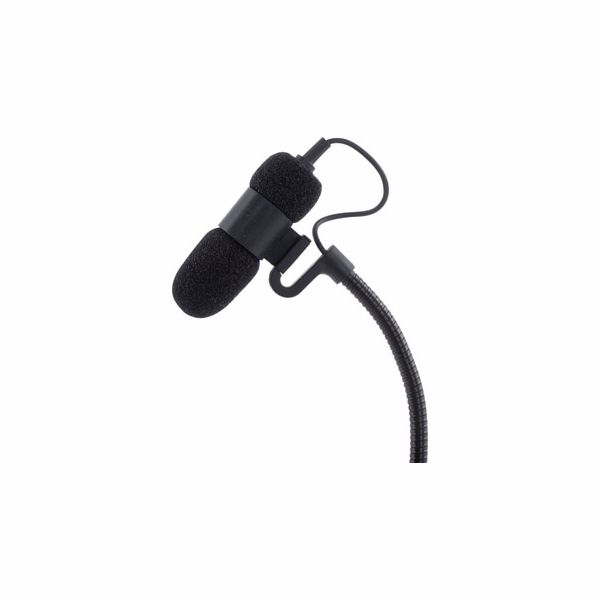Condenser Clip Microphone for Ovid System
- Directional characteristic: Cardioid
- Frequency response: 20 - 20,000 Hz
- Flexible gooseneck for an easy instrument setup
- 3-Pin Mini XLR connector for operation with t.bone wireless systems (also suitable for AKG wireless systems)
- Gooseneck length: 130 mm
- Cable length: 2 m
- Easy to install and can be used with different instrument clips (not included, must be ordered separately)
- Includes an XLR phantom power adapter (phantom power required) and a foam windshield
A clip mic that won't get in the way
The Ovid System CC 100 from the t.bone is a condenser clip microphone for recording musical instruments. Its cardioid polar pattern ensures that the sound of the respective instrument is picked up directly, and as it is designed for the t.bone's Ovid system and features a three-pole mini-XLR connection as its signal output, it is suitable for use with wireless systems from both the t.bone and AKG. As a condenser microphone, the CC 100 of course requires phantom power, so the scope of delivery includes an XLR phantom adapter that can also be used to connect the mic to a mixing desk, and the integrated 2m cable additionally allows a high degree of freedom. Altogether, this range of features makes the t.bone Ovid System CC 100 an affordable microphone for recording instruments with a direct, high-quality sound.
:format(jpeg))
Optimum signal transmission
The t.bone Ovid System CC 100 covers a frequency response from 20Hz to 20kHz with a maximum sound pressure level (SPL) of 110dB. The mic's sensitivity is 8.7mV/Pa, which means that slightly more amplification is required for an optimum signal transmission than in the case of a microphone with a high sensitivity level. Thanks to its signal-to-noise ratio of just 73.7dB, the proportion of noise in the signal is also minimised. It should be noted, however, that this microphone must be handled with the utmost case, as even dropping it can result in severe damage. For this reason, the microphone should always be stored in an optionally available microphone pouch or hardshell case when not in use, and it should only be cleaned using a moist cloth.
:format(jpeg))
Direct recording for instruments
This extremely compact clip microphone, which weighs just 88 grams, is ideal for miking up instruments during live performances, where users will certainly appreciate both its small design envelope and wide frequency response, while its cardioid polar pattern will keep the signal virtually free from unwanted sound from sources in the background. A range of instrument clips can also be ordered separately to allow the CC 100 to be attached directly to various acoustic (e.g. brass) instruments. By adding a wireless transmitter to the setup, musicians can then move around freely on stage without having to pay attention to how far their instrument is from the microphone. What is more, the scope of delivery additionally includes a foam windshield to prevent the occurrence of unwanted noise when the microphone is moved around.
:format(jpeg))
About the t.bone
Since 1994, the t.bone has been one of Thomann’s in-house brands, and its name can be found on devices such as headphones, wireless systems, in-ear equipment, and various microphones and matching accessories. “the t.bone” products are made exclusively by renowned companies who also manufacture products for other well-known brands. This provides a clear advantage: Brand-quality products at very reasonable prices. And word gets around: One in seven Thomann customers has already bought at least one product from the t.bone.
Flexible connectivity
The bottom of the t.bone Ovid System CC 100's gooseneck tapers off into a removable 2m cable, which features a three-pin mini-XLR plug that can be connected to the t.bone CC 100 EW phantom adapter and is lightweight enough to be pleasantly inconspicuous. The adapter in turn allows the microphone to be connected to a mixing desk, a multi-track recorder, or an audio interface, while the t.bone's optionally available Ovid System HD Cable EW lets the user connect it to Sennheiser's EW-series wireless systems. Last but not least, the gooseneck itself, which is 13cm in length, makes it possible to precisely align the t.bone Ovid System CC 100 microphone to its sound source.
-
the t.bone Small Diaphragm Condenser Microphones at a glance
-
Display Small Diaphragm Condenser Microphones from kr 500 - kr 1000
-
Go to product group Small Diaphragm Condenser Microphones
-
Go to product group Acoustic Guitar Microphones
-
Go to product group Microphones for Saxophone
-
Go to product group Microphones for Tuba, Euphonium ETC.
-
Go to product group Microphones for Trumpet, Horn ETC
-
Go to product group Piano Microphones
-
Go to product group String Instrument Microphones
-
Go to product group Microphones for Flutes
-
Go to product group Ovid Microphones Series
-
Go to product group Microphones for Toms
-
Go to product group Microphones
-
Show manufacturer details for the t.bone
-
the t.bone Microphones at a glance











